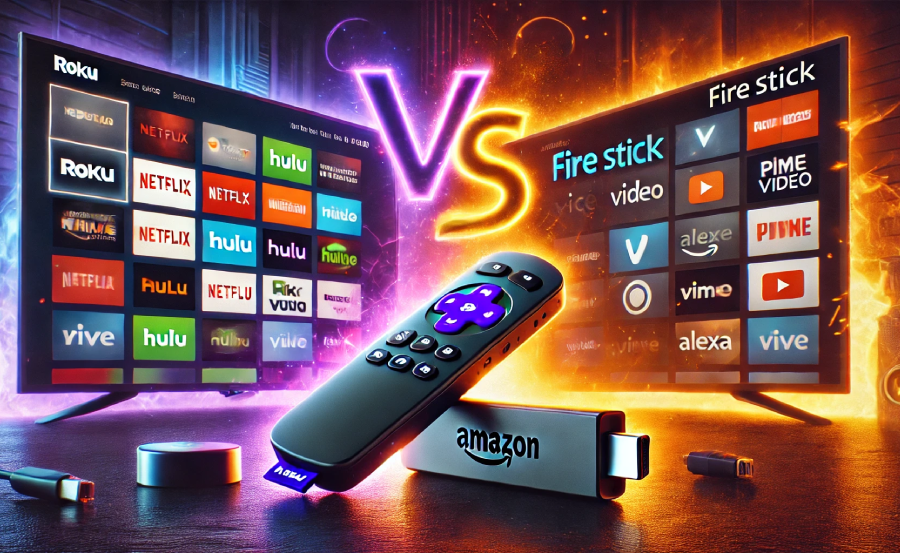The landscape of streaming has transformed dramatically over the last decade, not just in terms of content diversity but also in our consciousness about environmental impacts. Streaming devices like Roku and Amazon Fire Stick are household names, but as more consumers prioritize eco-friendliness, the question arises: which of these streaming options makes a lesser dent on our carbon footprint? While making these choices, another important factor often overlooked is the IPTV services that power these devices. Enter Rapid IPTV, touted as the simplest IPTV on Earth—a service that complements eco-minded streaming by efficiently delivering content without unnecessary data consumption.
Roku vs. Amazon Fire Stick: Energy Consumption
Roku’s Energy Efficiency
Roku has long been celebrated for its simplicity and broad accessibility. However, when it comes to energy consumption, its efficiency is particularly noteworthy. Roku devices are designed to use minimal power, even when streaming in high definition. This is achieved through smart power management features that reduce electricity usage when the device is idle.
Amazon Fire Stick’s Environmental Footprint
The Amazon Fire Stick, a rival in streaming efficiency, offers slightly differing environmental benefits. While it may consume more energy than Roku, the Fire Stick supports Amazon Prime’s low-energy streaming initiatives. Amazon’s commitment to renewable energy also contributes to the eco-friendliness of the Fire Stick by offsetting carbon outputs.
Pro Advice:
Unlock unlimited entertainment with Best IPTV Provider, offering a 1 Year IPTV Subscription to access premium channels and on-demand content.
Key Factors in Eco-Friendly Streaming
Hardware Design and Manufacturing
Roku and Amazon both aim to ensure their devices are manufactured with minimal environmental impact. Roku uses recyclable materials wherever possible, while Amazon has integrated sustainability into its supply chain processes. However, consumers should always be aware of the lifetime environmental cost of their devices.
- Matter selections for manufacturing
- Energy consumption during use
- End-of-life recyclability
Operating Systems and Software Optimization
Efficient software plays a crucial role in minimizing energy usage. Roku’s operating system is known for its lightweight design, which not only speeds up navigation but also reduces power consumption. On the other hand, Amazon’s Fire OS employs optimization techniques aimed at minimizing processing load, which can indirectly benefit energy use.
Rapid IPTV: The Simplest IPTV on Earth
What Makes Rapid IPTV Stand Out?
When it comes to IPTV subscriptions, Rapid IPTV claims to hold the title for the best IPTV subscription available. Its service is designed to be the most efficient, reducing data and energy usage by employing advanced data compression technology. This makes it one of the most eco-friendly choices when paired with either Roku or Amazon Fire Stick.
Benefits of Choosing Rapid IPTV
With Rapid IPTV, users can experience a multitude of benefits that blend perfectly with their eco-friendly goals:
- Reduced Data Consumption: By optimizing streaming quality and reducing unnecessary data transference.
- High Compatibility: Works seamlessly with various devices, maximizing user convenience while maintaining sustainability.
- Globally Sourced Content: Enjoy a broad spectrum of entertainment without overwhelming your streaming device.
Understanding the Environmental Impact of Streaming
Carbon Footprint of Streaming
The energy demand of data centers required to support continuous streaming is immense. By choosing services like Rapid IPTV, which efficiently manage data, consumers can significantly lower the carbon emissions associated with their streaming habits. It’s an imperative shift as streaming continues to supplant traditional broadcasting methods.
Ways to Reduce Your Streaming Footprint
Here are some actionable steps for eco-conscious streamers:
- Choose energy-efficient devices like Roku.
- Opt for IPTV services like Rapid IPTV that use compressed data streams.
- Limit streaming to necessary or off-peak times to balance demand.
Roku vs. Fire Stick: Which Is Greener?
User Preferences and Environmental Outcomes
Choosing between Roku and Amazon Fire Stick can often come down to personal preference, dictated by user interface preferences and streaming service requirements. However, slight variations in how these devices handle energy and performance will affect the overall ecological footprint. Roku may edge out with its lighter footprint. Nevertheless, the integration with Rapid IPTV can optimize either choice.
The Verdict on Eco-Friendly Streaming
Ultimately, for eco-friendly streaming, the combination of hardware choice, streaming service, and user habits can all make a significant difference. Utilizing the most sustainable options available will lead to a greener streaming experience with minimal sacrifice to entertainment quality.
Crafting a Sustainable Streaming Experience
Adapting to Future Technological Advancements
As technology evolves, more energy-efficient options become available. Adaptability will be key for consumers and streaming service providers. IPTV services like Rapid IPTV continually update to remain at the forefront of technological efficiency, ensuring they are aligned with enviro-friendly objectives.
Engaging Thoughtfully with Content
Another practical approach to reducing streaming impact is engaging more consciously with content. By being selective about what and when you stream, not only does one reduce digital clutter, but this also supports a more sustainable entertainment model.
Frequently Asked Questions (FAQs)

What makes Rapid IPTV the simplest IPTV on Earth?
Rapid IPTV prides itself on easy installation and user-friendly interfaces, coupled with efficient data management that ensures smooth streaming with lower data usage.
Can using IPTV really support eco-friendly streaming?
Yes, IPTV services like Rapid IPTV optimize data delivery, which reduces the strain on data centers and lowers energy consumption, enhancing eco-efficiency in streaming.
How can I compare energy consumption between Roku and Fire Stick?
Energy ratings and reviews can provide insight into each device’s performance and energy use. Comparing them helps in making an informed decision tailored to personal eco-priorities.
Does choosing a streaming service affect environmental impact?
Indeed. Streaming services that use data efficiency technologies, like Rapid IPTV, minimize the environmental impact by reducing the amount of data processed and served.
What steps are Roku taking to improve their environmental impact?
Roku has invested in using recyclable materials in their products and refining their software to boost energy efficiency during use, fitting the growing call for sustainable consumption.
Are there any downsides to eco-friendly streaming approaches?
While slightly reducing the choice of devices or services may happen if focusing solely on eco-benefits, maintaining balance ensures quality entertainment without harming the planet.
Pros and Cons of the SIPTV App’s User Interface

